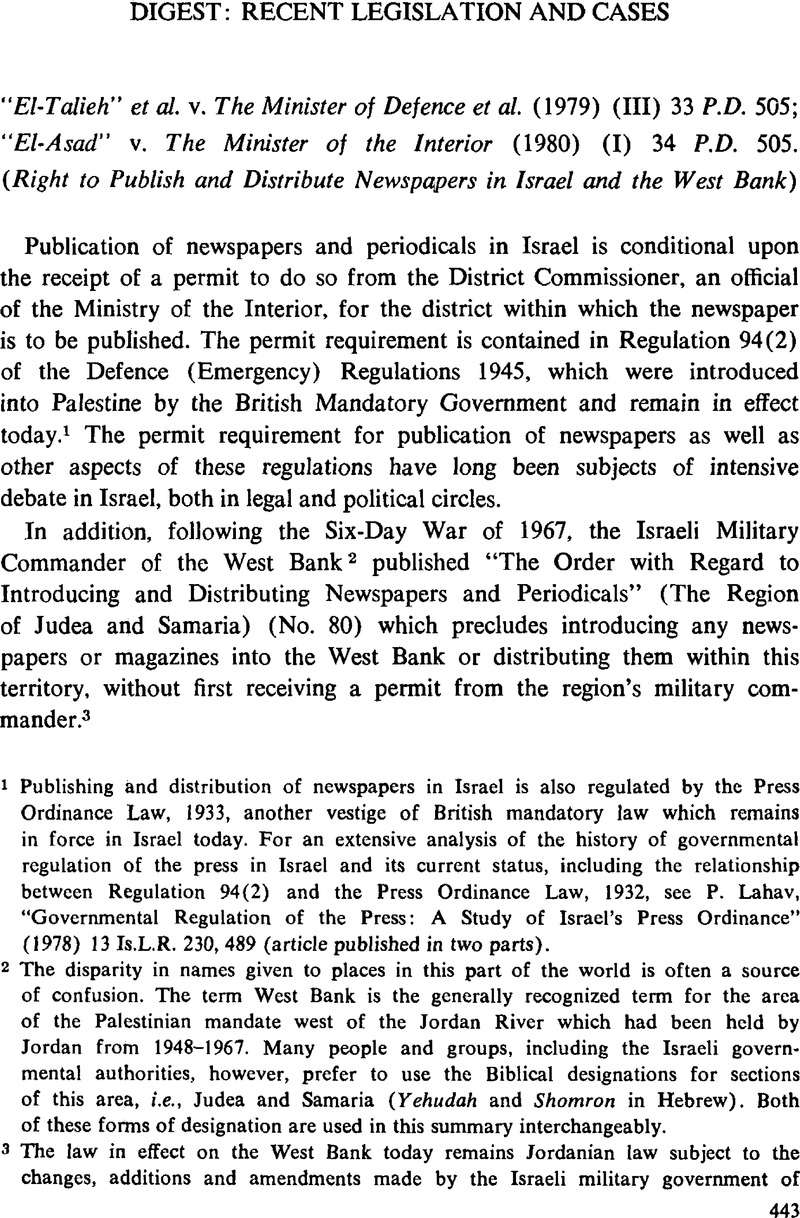No CrossRef data available.
Published online by Cambridge University Press: 12 February 2016

1 Publishing and distribution of newspapers in Israel is also regulated by the Press Ordinance Law, 1933, another vestige of British mandatory law which remains in force in Israel today. For an extensive analysis of the history of governmental regulation of the press in Israel and its current status, including the relationship between Regulation 94(2) and the Press Ordinance Law, 1932, see Lahav, P., “Governmental Regulation of the Press: A Study of Israel's Press Ordinance” (1978) 13 Is.L.R. 230, 489Google Scholar (article published in two parts).
2 The disparity in names given to places in this part of the world is often a source of confusion. The term West Bank is the generally recognized term for the area of the Palestinian mandate west of the lordan River which had been held by Jordan from 1948–1967. Many people and groups, including the Israeli govern mental authorities, however, prefer to use the Biblical designations for sections of this area, i.e., Judea and Samaria (Yehudah and Shomron in Hebrew). Both of these forms of designation are used in this summary interchangeably.
3 The law in effect on the West Bank today remains Jordanian law subject to the changes, additions and amendments made by the Israeli military government of the area pursuant to its authority. This regulation is an example of such an addition instituted by the Military government.
4 In terms of Israeli law, Jerusalem, including the portion of the city held by Jordan from 1948–1967, commonly known as East Jerusalem, is an integral part of the State of Israel and, as such, completely subject to Israeli law. See Law and Administration Ordinance (Amendment No. 11) Law, 1967, 21 L.S.I. 75; Ravidi v. The Military Court (1969) (II) 24 P.D. 419.
5 Since the instant case was decided, the military authorities on the West Bank prohibited the distribution on the West Bank of two of those other Arabic language newspapers published in East Jerusalem. However, following the filing of petitions to the High Court of Justice and the issuance by the court of show cause orders, the prohibition as to one of them was rescinded. At the time of this writing the petition of the second newspaper is pending before the High Court of Justice.
6 See n. 3, supra. It should be noted that the Israeli Communist Party is a legal political party that is represented in the Knesset, the Israeli legislature, as it has been since the beginning of the State.
7 13 L.S.I. 7.
8 See Shapira v. The Jerusalem District Committee of the Bar Assoc. (1971) (I) 25 P.D. 325, 334.
9 Sec. 3 (1), supra n. 7.
10 See El Arad Co., Ltd. v. the District Commission for the Northern District, Nazareth, (1964) (II) 18 P.O. 340.
11 Cf. Leedom v. Kyne, 358 U.S. 184, 79 Sup. Ct. 180, 3 L. Ed. 2d 210 (1958); Harmon v. Brucker, 355 U.S. 579, 78 S. Ct. 433, 2 L. Ed. 2d 503 (1958).
12 Kol-Ha'am v. Minister of Interior (1953) 7 P.D. 871.
13 For analyses of the development of freedom of speech and the press in Israel see P. Lahav. supra n. 1, and Lahav, P., “Freedom of Publication, a Citizen's Right to Know and Official Secrets” (1975) 6 Mishpatim 562.Google Scholar
14 Compare the opinion of the court in the Eilon Moreh case, discussed in Goldstein, S. and Schottenfelds, D., “Digest: Recent Legislation and Cases” (1980) 15 Is.L.R. 137.Google Scholar
page 451 note 1 25 L.S.I. 152.
page 451 note 2 See, for example Yadin, Uri, “The New Law of Contracts in Action” (1979) 14 Is.L.R. 104.Google Scholar